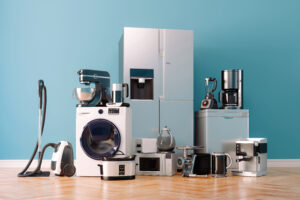5 Common Home Appliance Problems and How to Fix Them

*Updated April 7th, 2025
Home appliances are the unsung heroes of our daily routines. From washing dishes to keeping our food fresh, they make life a whole lot easier. But when they start acting up, it’s a whole different story. A broken appliance can quickly turn your day upside down, leaving you with a pile of dirty dishes or a fridge full of spoiled food.
While calling a professional is always an option, it can be costly and time-consuming. The good news? Not every appliance issue requires an expert. Some of the most common problems can be tackled with a bit of basic know-how and a few simple tools.
In this article, we’ll dive into five common appliance issues and show you how to fix them yourself. Whether it’s a leaky dishwasher or a finicky dryer, we’ve got you covered with practical tips to get your appliances back in working order—without breaking the bank.
1. Washing Machine Not Draining
There’s nothing worse than popping open your washing machine after a cycle only to find a soggy, sopping mess at the bottom. A washing machine that won’t drain properly can throw off your entire laundry routine, but don’t stress—there are a few things you can check before dialing up a repair service.
First, let’s start with the drain hose. This flexible tube carries water out of your machine, but it can easily get twisted, kinked, or even clogged over time. Take a look behind your washer to make sure the hose isn’t bent or pinched. If it looks fine from the outside, disconnect it and inspect the inside for any blockages—like lint, small items, or even detergent buildup. Clearing out any obstructions might just do the trick.
Next up: the drain pump filter. Most washing machines have a filter to catch small objects that sneak out of your pockets—think coins, hairpins, and even the odd sock fluff. This filter is usually located near the bottom of the machine, often behind a small access panel. Make sure your machine is powered off, then carefully remove the filter and give it a good clean. You might be surprised at what’s trapped in there! Rinse it under warm water and remove any stuck-on debris before putting it back.
If the hose and filter both check out but your washer still isn’t draining, it might be a problem with the drain pump itself. Listen for any odd noises during the spin cycle—like a loud buzzing or grinding sound—which can indicate a faulty pump. You can also carefully inspect the pump’s impeller (a small, fan-like part) to make sure it’s not stuck or broken. If the pump isn’t working correctly, it may need to be replaced.
If none of these fixes solve the problem, it could be a more complex issue—like a broken belt or motor malfunction. In that case, it’s probably best to call in a professional to take a closer look.
Tackling these simple checks first can save you time and money, and you just might get your machine draining properly again
2. Dishwasher Not Cleaning Properly
There’s nothing more annoying than unloading your dishwasher only to find food residue and water spots still clinging to your dishes. It might not happen overnight, but over time, you might notice your dishwasher just isn’t doing its job as well as it used to. If your once-reliable appliance is leaving you with dirty plates and cloudy glasses, it’s time to do a little troubleshooting.
First, take a look at the spray arm. This part spins around during a cycle, blasting water onto your dishes. If the spray arm gets clogged with food particles, mineral deposits, or other debris, it can’t rotate properly or spray water as effectively. Remove the arm (check your manual if you’re not sure how) and inspect the holes for blockages. Clean out any gunk with a toothpick or a small brush. Once it’s clear, pop it back in place and run a cycle to see if things improve.
Next, don’t forget to check the filter. Many dishwashers have a filter located at the bottom, and it’s there to catch larger food particles. If the filter is dirty or clogged, your dishes will come out grimy no matter how hot the water gets. Take out the filter, give it a good rinse under warm water, and scrub away any stuck-on bits. For stubborn grime, soaking it in a mixture of warm water and vinegar can help.
If your dishes are still coming out dirty after cleaning the spray arm and filter, it might be a more serious issue—like a clogged pump or a faulty motor. These problems can reduce water pressure and circulation, making your dishwasher less effective. At this point, it’s best to call a professional to inspect and repair the problem.
Keeping your dishwasher in good shape isn’t just about clean dishes—it also helps your appliance last longer. Regularly cleaning the spray arm and filter can save you a lot of hassle down the road and ensure your dishwasher keeps doing its job right.
3. Oven Not Heating Up
When your oven suddenly stops heating up, it can throw a wrench in your dinner plans. Don’t panic—there are a few things you can check before calling in a professional.
First, make sure the oven is properly plugged in and that your circuit breaker hasn’t tripped. Sometimes, the simplest explanation is the right one! If the power source checks out, it’s time to look at the heating elements. Most electric ovens have both a bake and a broil element, and if one of them has burned out, the oven won’t heat properly. You can usually spot a faulty element if it looks blistered, cracked, or discolored.
Next up: the temperature sensor. If your oven is heating, but not reaching the right temperature, the sensor could be the issue. It’s typically located inside the oven and looks like a thin, metal probe. If it’s malfunctioning or not properly connected, your oven might not heat evenly—or at all.
If you’re comfortable with basic DIY, you can test the sensor with a multimeter to see if it’s working correctly. If it’s faulty, replacing it is usually straightforward. However, if the problem lies with the control board or wiring, it’s best to call a professional.
4. Dryer not Drying Clothes
Nothing’s more frustrating than unloading a dryer only to find your clothes are still damp and cold. If your dryer isn’t doing its job, don’t worry—there are a few things you can check before calling a technician.
First, start with the basics: make sure the dryer is properly plugged in and that the circuit breaker hasn’t tripped. Power issues are surprisingly common, and fixing them is often as simple as resetting a breaker or plugging the dryer back in securely.
Next, take a look at your settings. Sometimes, it’s just a matter of accidentally selecting a “no heat” or “air fluff” option instead of a proper drying cycle. Double-check that you’ve chosen the right setting for the type of load you’re drying.
One of the most common culprits is lint buildup. Check the lint trap and clean it out if it’s full. But don’t stop there—lint can also accumulate in the dryer vent or duct, blocking airflow and preventing clothes from drying properly. Disconnect the vent hose and inspect it for blockages, then give it a good clean. You’ll be surprised how much lint can sneak past the filter!
Another thing to consider is the dryer’s exhaust vent. If it’s clogged or kinked, it can reduce airflow and trap moisture inside. Make sure the vent isn’t crushed or blocked by anything outside.
Finally, if your dryer is still not drying efficiently, it could be a problem with the heating element, thermostat, or thermal fuse. These components may need to be tested and replaced by a professional.
Once you’ve checked and cleaned everything, run a test load to see if your dryer is back in action.
5. Dripping AC Window Unit
There’s nothing better than the cool blast of a window AC unit on a hot summer day—until you notice it’s dripping water all over your floor or windowsill. A leaking AC can be frustrating, but it’s usually a sign that something’s not quite right with the drainage system or the way the unit is installed.
First things first: why is your AC dripping in the first place? Window units naturally produce condensation when cooling the air, but that moisture should drain outside. If water starts pooling inside or dripping where it shouldn’t, it’s often because the drainage system is clogged with dirt, dust, or debris. Over time, gunk can build up and block the drainage hole, causing water to back up and leak out from unexpected places.
To fix this, power off your unit and carefully remove it from the window if possible. Check the drainage hole and clean it out with a small brush or pipe cleaner to ensure there’s no blockage. Sometimes, just clearing the drain can make a big difference.
Another common issue is the installation angle. Your window AC should be slightly tilted towards the outside—just enough to encourage water to drain away from your room. If it’s level or tilted inward, water will pool inside and eventually leak. Adjust the angle by shimming the back of the unit slightly, and make sure it’s secure before turning it back on.
If you’ve cleaned the drainage system and adjusted the angle but it’s still leaking, the problem could be a bit more complicated—like a damaged condensate pump or a problem with the internal components. In that case, it might be time to call in a professional to take a closer look.
Keeping your AC well-maintained and properly installed can save you a lot of hassle.
Conclusion
FAQ
Why are all of my appliances breaking all of the time?
Power surges can wreak havoc on appliances, leading to major breakdowns. What causes them? Severe weather and downed power lines are the usual suspects – but faulty wiring in your own home could be at fault too!
What is the lifespan of appliances?
Most major appliances should last 8-15 years. Homeowners can also make repairs before fully replacing an appliance to make them last even longer.
What appliances wear out quickly?
Appliances that come in contact with water are more likely to break down. In general, dishwashers tend to break more than most home appliances.
Additional Appliance Resources
- How to Extend the Lifespan of Your Appliances
- Troubleshooting Tips for Common Washer and Dryer Problems
- The Top Home Appliances that Can Save You Money

Anna has over six years of experience in the home services and journalism industries and serves as the Content Manager at MyHomePros.com, specializing in making complex home improvement topics like HVAC, roofing, and plumbing accessible to all. With a bachelor’s degree in journalism from Auburn University, she excels in crafting localized, comprehensive guides that cater to homeowners’ unique needs. Living on both coasts of the United States has equipped her with a distinctive perspective, fueling her passion for turning any house into a cherished home through informed, personalized decision-making.
Connect with top-rated local contractors who can help you with siding, roofing, HVAC, windows, and more. Get free quotes from verified professionals in your area today.








